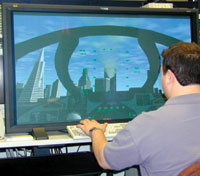| GCN STAFFPlastering a message across a billboard is a good way to make sure people see it. In the computer world, you need plasma instead of plaster.Plasma monitors have until recently been so high-priced that few users could afford them. The return on investment rarely justified the cost.Now the behemoths are dropping in price and improving in quality. The GCN Lab took a look at four of the biggest plasma units on the market, each measuring at least 50 inches on the diagonal, to see which gave the best performance for the price.Plasma monitors differ from just about any other type of display, and not just in size. A 50-inch LCD would be massive in comparison.A 50-inch CRT would probably weigh close to 600 pounds. The lab's test units averaged less than 100 pounds.The electron gun of a CRT, the part that juts back behind the screen, would have to be several feet long to produce a display so large.Plasma monitors don't have electron guns. The largest panel in the review was only 4 inches thick. Considering their huge display size, these units are tiny.Each pixel of a plasma monitor can produce red, green and blue light independently. All the pixels light up simultaneously, too, so there is no scanning to distort the image as with a CRT.Unlike an LCD, a plasma display does not require backlighting or polarization. That produces sharper images visible in any setting, from a dim theater to a well-lit gymnasium, or even in direct sunlight.Here's how it works. An electrical discharge, released by electrodes sandwiched between two glass panels, briefly excites an inert gas filler, mostly xenon, into an ionized form of matter called plasma.The plasma gives off ultraviolet radiation, which lights up the red, green or blue phosphor in each pixel. It is unaffected by ambient magnetic fields, so you can safely put computer speakers right beside the monitor.Plasma produces the most brilliant picture quality yet seen on monitors, regardless of whether the input is an analog or digital stream or High-Definition TV.The lab tested this versatility with four types of input. The sources included a standard analog signal from a PC video card with a special wide, 16-9 ratio; a digital signal from the same card; a digital signal through an SVideo cable from a DVD player; and a standard digital video card signal.The lab awarded extra points for easy setup and simplicity of the controls.All four reviewed monitors had fantastic image quality, but the excelled in the area plasma buyers care about most: presentations.The 50MP1 reproduced images with amazing quality. Color contrasts were so vibrant that they enhanced otherwise boring images. The 50MP1 tended to be brighter than the other units and did not wash out colors.The panel was easy to configure because it arrived with a sturdy metal base. The lab didn't have to attach plastic feet or screw anything in to secure it. The base did increase weight somewhat, but that disadvantage was offset by its readiness for use. The detachable base added another 11 pounds to the 50MP1's 101 pounds.One reason behind the 50MP1's excellence in presentation graphics was the 0.81- by 0.81-mm pixel pitch. Although the monitor had a wide 16-9 aspect ratio, it did a good job of stretching images with little distortion.Image distortion is a concern with any plasma display, because most computer video cards are configured for a 4-3 ratio of width to height. Circles look slightly oval on a plasma display, but you generally cannot notice any difference with photographs.Connected to a digital 16-9 ratio video card, the 50MP1's images looked perfect.It did have some flaws. Compared to the other units, it was the poorest at displaying ordinary images such as Web pages through an analog connection with a standard 4-3 ratio video card. The monitor just couldn't quite synchronize in analog. Its slight blurring would produce eyestrain in a user trying to read standard 12-point text.Anyone who buys the 50MP1 as a computer monitor should get a 16-9 digital video card, or at least a standard card with digital output.A huge plus was that the 50MP1's multiple input ports lined up along the right side. All the other review units had hard-to-reach inputs along the bottom. If one was sitting on a table, I couldn't easily lift it to ensure connecting the cables correctly. But the 50MP1's side ports were always in reach. The lab staff spent the least time handling it because it was so easy to hook up and change input sources.Oddly enough, the power button was on the bottom, whereas the other monitors had a button on the side. But one button in an odd spot is better than an entire row of input ports placed where you can't get at them.The must be the world's largest computer monitor. Unlike the NEC 50MP1, the 502MX seemed geared more to that use. It had less brilliant color contrast but did an amazing job as a computer display.With a standard analog video signal, text was crisp and easy to read. I plugged the 502MX into several standard video cards and saw crisp, easily readable images, especially for tasks such as Web browsing.If you want a plasma monitor to show off Web presentations or text data, this is the one to buy. Out of the box with no special equipment, it performed quite well. The trade-off was that the screen looked less spectacular for video presentations.Through an SVideo connection, video quality was above average. Photographs didn't have the same hypercontrast or sheen as on the NEC unit. Images displayed correctly, just without extra flair.The 502MX was comparatively light at 89 pounds, easy for two people to carry. Setup, however, required mounting the monitor on two little plastic feet and then bracing the feet with long steel screws. That took a while. Also, the inputs on the bottom were fairly difficult to reach.The lab staff first set up the 502MX on a rack-mount testing platform against a wall. To connect cables, staff members had to squeeze in behind the rack. There was 4 inches of clearance from the bottom of each port to the tabletop.An RGB cable has 2 inches free at the ends, so there was not a lot of room to play with. I couldn't see which way the plug was angling on combination and SVideo cables. The only solution was to enlist a helper or two to prop up the monitor'very carefully because of its high price, weight and fragility.The 502MX did get credit for having a fairly small footprint. It was quite thin, and the plastic feet stuck out only 5 inches. In limited space, say aboard ship or on a small conference room table, the 502MX will deliver the maximum impact in the minimum real estate.Interestingly, the performed in all tests exactly like the Pioneer PDP-502MX. It weighed the same down to a fraction of a pound. It had the same strengths and weaknesses and behaved the same with all inputs.When the staff put the monitors side by side and ran through the same series of images, they were identical on the two units. The only difference I found was that the VPW500 is cheaper overall.I concluded that the ViewSonic VPW500 and the Pioneer PDP-502MX are the same hardware with different labels. The ViewSonic sticker fell off during testing, apparently having been attached some time after manufacture.Such relabeling is fairly common in the computer industry. Only a handful of factories in the world make notebook computers, for example, and different makers' models look similar, but usually they have slightly different components inside.These two plasma monitors are for all practical purposes identical. Choose whichever costs you less.The straddled the line between a presentation monitor and a computer monitor. It performed outstandingly on tests and gave the top scores. It earned the only overall A' grade, as well as the Reviewer's Choice designation.The FlexScan P5071 was heavy, weighing in at 103 pounds without the base, which had plastic feet and metal screws adding two more pounds. But the P5071 had one nice setup feature the other monitors lacked: built-in steel carrying handles. There were four handlebarlike holding areas, so two people could move the unit without touching the fragile glass front. Easy transport more than made up for the extra setup and weight.The P5071 also had conveniently placed ports. They were not along the side like the NEC's, but they weren't at the bottom, either. There was enough clearance to connect cables without having to crouch and peer.The controls were versatile and easy to use. With the remote control, the lab staff could make the monitor show multiple panels, smooth the image quality or freeze the screen. It could even set up inputs for a DVD movie and a slide of data at the same time.The monitor's presentation performance stood out. Digital video looked great, either from a home-type DVD system or as a PC video card stream. The FlexScan did not quite measure up to the NEC's display quality, but it was close. And it worked far better than the NEC as a computer monitor.The P5071 is the right plasma choice if you are not 100 percent sure what applications or input sources you will use. It does a great job with all of them.Even though plasma display technology was invented at the University of Illinois way back in 1964, early units did little more than project points of light and geometric shapes. The inventors could not have envisioned the colorful applications running on plasma screens today.Crisp, movie-quality digital video, brilliant presentations and eye-popping color images are par for the course. As prices continue to drop, expect to see more of these giants make their way into the office.XXXSPLITXXX- indicates a desirable attribute or best performance; indicates an undesirable attribute or worst performance.
A plasma monitor is big enough to run simulations that go over, under, around and through large structures.











